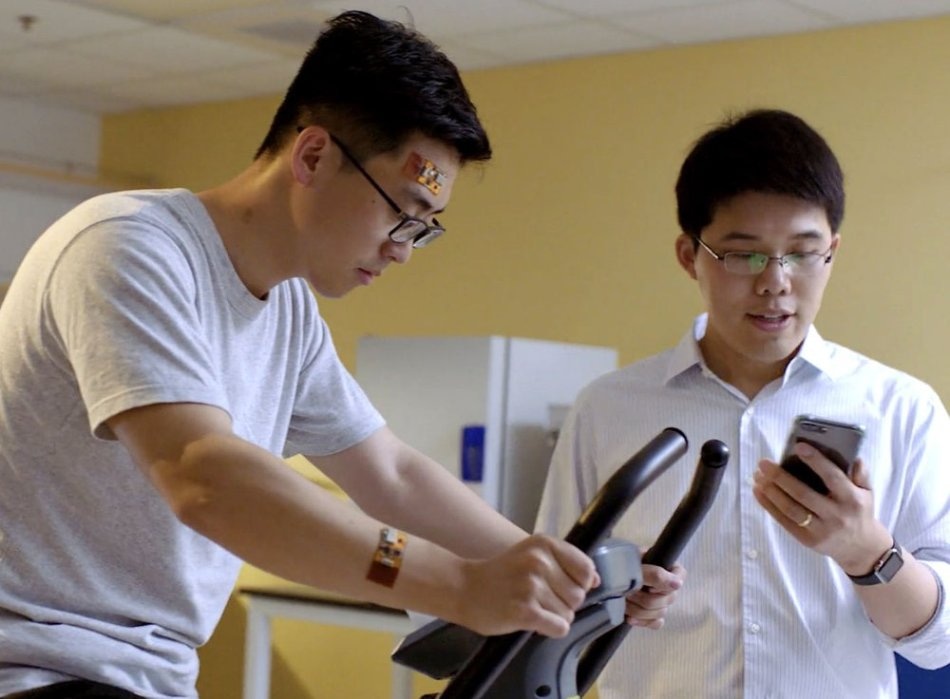Nov 26 2019
Several things make people dislike a visit to the doctor such as sitting in the waiting room and people coughing without covering their mouths.
 Wei Gao, at right, monitors data from flexible sweat sensors worn by a volunteer. Image Credit: Caltech.
Wei Gao, at right, monitors data from flexible sweat sensors worn by a volunteer. Image Credit: Caltech.
However, for many, the worst thing about a doctor’s visit is the fear of needles. Blood tests are a proven way of assessing the inner workings of the body, but the discomfort is inevitable. Or maybe not, say Caltech researchers.
Scientists led by Wei Gao, assistant professor of medical engineering, have built a mass-producible wearable sensor that can track levels of nutrients and metabolites in a person’s blood by evaluating their sweat.
Sweat sensors developed earlier typically targeted compounds that occur in high concentrations, such as glucose, electrolytes, and lactate. Besides being easier to manufacture, Gao’s sweat sensor is more sensitive than existing devices and can detect sweat compounds of very low concentrations, the scientists say.
The advent of such sensors would enable doctors to continuously track the condition of patients with ailments like diabetes, cardiovascular disease, or kidney disease, all of which lead to irregular levels of metabolites or nutrients in the bloodstream. It would be beneficial for patients to have their physician well aware of their condition, while also avoiding painful and invasive sessions with hypodermic needles.
Such wearable sweat sensors have the potential to rapidly, continuously, and noninvasively capture changes in health at molecular levels. They could enable personalized monitoring, early diagnosis, and timely intervention.
Wei Gao, Assistant Professor of Medical Engineering, Caltech
The focus of Gao’s study is on building devices based on microfluidics, a term for technologies that manipulate minute amounts of liquids, typically via channels with a width of less than a quarter of a millimeter.
Microfluidics are perfect for an application of this kind as they curtail the influence of skin contamination and sweat evaporation on the sensing accuracy. As freshly supplied sweat flows via the microchannels, the device can make more precise sweat measurements and can record temporal variations in concentrations.
According to Gao and his colleagues, so far, microfluidic-based wearable sensors were typically fabricated with a lithography-evaporation process, which necessitates complicated and costly fabrication processes. By contrast, his team chose to make their biosensors using graphene, a sheet-like form of carbon.
The graphene-based sensors, as well as the miniature microfluidics channels, are built by engraving the plastic sheets with a carbon dioxide laser, a device that is currently so common that it is can be purchased even by home hobbyists.
The researchers chose to have their sensor measure heart rate, respiratory rate, and levels of tyrosine and uric acid. Tyrosine was selected because it can signify metabolic disorders, eating disorders, liver disease, and neuropsychiatric conditions.
Uric acid was selected because, at higher levels, it is related to gout, a painful joint condition that is on the rise worldwide. Gout happens when high levels of uric acid in the body start to crystallize in the joints, especially those of the feet, causing inflammation and irritation.
To test how well the sensors worked, the team conducted a series of tests with healthy individuals and patients. To check sweat tyrosine levels, which are impacted by a person’s physical fitness, they used two sets of people: individuals of average fitness and trained athletes. As predicted, the sensors exhibited lower levels of tyrosine in the sweat of the athletes.
To study uric acid levels, they monitored the sweat of a group of healthy persons while they were fasting, and also after they ate a meal rich in purines, compounds in food that are metabolized into uric acid. The sensor displayed an increase in uric acid levels after the meal. Gao’s team also conducted a similar test with gout patients. The sensor revealed that their uric acid levels were a lot higher than those of healthy individuals.
To verify the precision of the sensors, the scientists also took blood samples from the gout patients and healthy individuals. The sensors’ measurements of uric acid levels matched well with levels of the compound in the blood.
According to Gao, the high sensitivity of the sensors, together with the simplicity with which they can be manufactured, means they could ultimately be used by patients at home to check conditions like diabetes, gout, and cardiovascular diseases. Having correct real-time information about their health could even enable patients to regulate their own medication levels and diet as necessary.
Considering that abnormal circulating nutrients and metabolites are related to a number of health conditions, the information collected from such wearable sensors will be invaluable for both research and medical treatment.
Wei Gao, Assistant Professor of Medical Engineering, Caltech
The paper describing the study, titled “A laser-engraved wearable sensor for sensitive detection of uric acid and tyrosine in sweat,” has been published in the November 25th issue of Nature Biotechnology.
Co-authors of the study are Yiran Yang (MS ’18), Yu Song, Xiangjie Bo, Jihong Min (MS ’19), Minqiang Wang, Jiaobing Tu, and Adam Kogan of Caltech; Haixia Zhang of Peking University; On Shun Pak of Santa Clara University; Lailai Zhu of Princeton; and Tzung K. Hsiai and Zhaoping Li of UCLA. Hsiai is also a visiting associate at Caltech.
The study was funded by the Rothenberg Innovation Initiative program, the Carver Mead New Adventures Fund, and the American Heart Association.